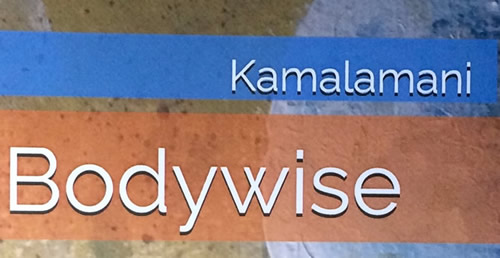Kirtan Kriya
Dr. Christopher Walling, PsyD, C-IAYT shared work he is doing at the Alzheimer's Research and Prevention Foundation during his webinar sponsored by the United States Association for Body Psychotherapy. He presented current research outcomes regarding the delayed onset of Alzheimer's as well as age related cognitive decline and ways to incorporate yoga and meditation to offset the loss of memory and cognition. He shared the work being done with Kirtan Kriya, a 12-minute daily meditation that is yielding significant research results that involve the posterior cingulate gyrus (increases in blood flow that allow the brain to grow new brain cells), and improvements in concentration, focus and attention. You can experience this process by clicking the video link on our homepage.
Curiosity is one way out of Stuckness
One of the top complaints I hear from people who come into my office is “I’m stuck.” What they are saying without realizing it is that they’re stuck in repeating scenes with repetitive themes in their lives, either with the same or different people, over and over again.
Seasonal Affective Disorder
When daylight hours start to decrease and it gets colder outside many people may find themselves experiencing symptoms resembling depression. For some the symptoms are relatively brief. Tempers may seem shorter for parents stuck inside with cranky or sick children and an increased sense of lethargy is not uncommon on a dreary winter day. For others, however, these symptoms can be quite disabling.
My Stuffed Co-Therapists
In my office I have stuffed animals - a rabbit, a dog, and a bear that sit together on one of my sofas. They represent an alternative somatic psychotherapy. Treatment with them involves talk, but it also involves touch and somatic awareness. Clients usually don’t notice them. However, often in therapy, themes emerge that arise from my clients' repressed bodies. These themes deal with both present and past events and how these clients were treated by their parents. This information is presented to me both quickly and as an affectionless series of stories. I stop my clients. I encourage them to take full slow breaths, to place their feet hips' width apart on the floor. Then I ask them if there is a feeling beneath the story that they are telling me. Often, after the breaths, they come back to the story slower but void of feelings.
At this point I change the focus and ask them if they are drawn to one of my co-therapists — the bear, the dog, or the rabbit—and let them make their choice. After choosing, their fingers may start to caress or grip the co-therapist of their choice.
Mindfulness
Mindfulness is trending. It’s been on the forefront of conversations in terms of Western therapeutic methodologies since Jon Kabat Zinn integrated it into his Mindfulness-Based Stress Reduction program (MBSR) in the early 1980s. Today, mindfulness practices are at the heart of many psychotherapeutic approaches such as: mindfulness-based cognitive therapy (MBCT); acceptance and commitment therapy (ACT); dialectical behavior therapy (DBT); mindfulness-based relapse prevention (MBRP); mindfulness-based trauma therapy (MBTT); and mindfulness-based eating awareness training (MB-EAT). The word itself, however, is often confused. Its meaning subjectively associated with who or what entity is promoting its use. There’s clearly a difference between Eastern approaches to meditation and mindfulness and the current Western emphasis. With the proliferation of modalities integrating components of meditation and mindfulness practice, this book is a welcome addition to Hogrefe’s Advances in Psychotherapy: Evidence Based Practice Series—noted as Volume 37.
Diving Into the Healing: Trusting the Heart
Vacillating between emotional pain and the somatic relief of psychic numbing, Marie came to my office bewildered and in shock. Two weeks earlier a truck had crashed into a car in which Marie’s mother was riding. Although the truck driver had survived, Marie’s mother and her partner had instantly died.
“I don’t know how you can help,” Marie said, her tired eyes revealing her grief. “You can’t bring my mother back or help me make sense of my loss. I’ve always had faith in a divine spirit, in an afterlife, but now nothing seems right.”
Given the traumatic impact of Marie’s loss, how could I help?
Change the Story of Your Health
Shamanism and Jungian analysis—the transpersonal realm and the unconscious. As George Hogenson, PhD, notes, Carl Greer offers “A remarkable melding of Jung’s analytical psychology and the ancient, and global, traditions of shamanic healing . . .” in his newest book, Change the Story of Your Health: Using Shamanic and Jungian Techniques for Healing.
Open the Gift of Mindful Awareness
It’s already starting. Holiday decorations are showing up at the stores, music is playing at the mall, pumpkin lattes abound. The cultural and familial buildup to this season is magnified every year and, for many people, becomes totally overwhelming.
The experience of “too much” can replicate traumatic overwhelm in our nervous system, creating a whole season of nervous system dysregulation. This dysregulation then creates heightened emotions and reactivity (“What!? They didn’t make a vegan pumpkin pie??!”), depression and anxiety (“They don’t like my gift or I have to get the perfect gift”) and often a desire to literally escape the season’s events (fleeing by not going to the party) or a desire to dissociate (fleeing by leaving your body - I’ll just be on my phone for the whole dinner).
How can we assist our clients and ourselves in navigating this extended stressful season?
Therapy in the Moment: Dissociating to Make it Through the Present
What do you think of when you hear the word “dissociate”?
Do you wonder what it means, or think “I never do that” or maybe, “that’s my go-to reaction”, or anything in between?
What is dissociation?
The dictionary tells us it is separation, disconnect of parts (dictionary.com). So how does it show up in our psyche?
Dissociation can be any moment you might disconnect from the present moment.
Generally, in psychology, it is discussed within the context of extreme trauma cases as a full separation from reality leading to disorders. Yet it is in our daily life as well.
Somatic Relief for The Blues
Walking over to my chair, cell phone in hand, Bev exclaimed (the tone of her voice implying the answer was a given to her upcoming question), “Aren’t these pictures beautiful? Here, look at this one—I took it from the old Fort. Can you spot the house in the background across the inlet? That’s where my father would put the boat in the water to take us up the coast. Those were good times.” Bev’s photographs, composites of her beloved seas and shorelines along Maine’s southern and mid-coast, comprise a visual memorial to the beaches and bays that provided a measure of playfulness and serenity within the more chronic and painful vagaries of her childhood and adolescence.











